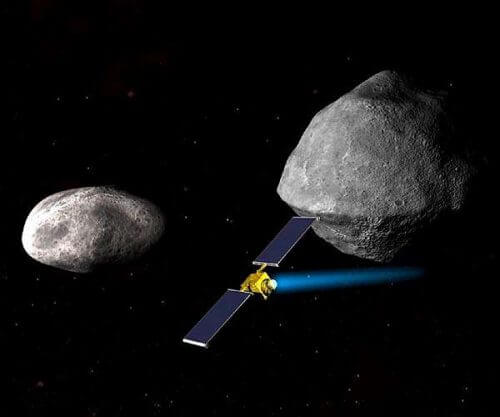The spacecraft will fly to the double asteroid Didymus, and on this occasion it will explore both asteroids, and finally it will throw itself on the smaller of the two into a collision course at a speed of 6 kilometers per second to deviate slightly from its orbit around the larger asteroid

The first mission to examine a system to protect the Earth from asteroids by deflecting them moved to the planning and assembly stage following approval by NASA on August 16.
The DART test spacecraft (Double Asteroid Redirection Test), designed in the Applied Physics Laboratory at Johns Hopkins University in Maryland, will test the effector impact method to move the asteroid using the kinetic energy of the spacecraft itself that will hit the asteroid. NASA sees great importance in this experiment because it is a step towards establishing a defense system for the Earth against asteroids.
The Target Redirection Test (DART), designed, built and managed by the Johns Hopkins Applied Physics Laboratory in Laurel, Maryland, will test the so-called kinetic effector technique - striking an asteroid to shift its trajectory - and take a critical step in demonstrating how to protect on our planet from potential impact. DART's target is the asteroid Didymos (Greek for "twin"), a double system consisting of Didymos A, an asteroid about 2 km wide, and a smaller asteroid orbiting it called Didymos B, which is about 500 meters in diameter. After the launch in the spring or summer of 2021, the spacecraft will fly towards the asteroid Didamus B, and crash into it at a speed of 6 kilometers per second.
"Through DART, we want to understand how the asteroid reacts after hitting it, in order to apply the knowledge if we are required to face the need to deflect an object that threatens to crash into the Earth," said Andrew Rivkin of APL, a co-researcher on the mission. "Also, DART will be the first spacecraft to visit a binary asteroid system, which is an important, unexplored subset of near-Earth asteroids."
The impact will cause a very small change in the orbital speed of the asteroid. Observers on Earth will determine the change in Didymus B's orbit around Didymus A, allowing scientists around the world to better determine the capabilities of the kinetic impact method as an asteroid deflection strategy.
To assess and develop capabilities to deal with potential asteroid threats, NASA established its Planetary Coordination Office in 2016, which is responsible for detecting, tracking, and characterizing dangerous asteroids and comets approaching Earth, while providing warnings about impacts and assisting U.S. government response coordination programs. b to the actual threat of injury. As we know, this is not a theoretical threat, about 65 million years ago a large asteroid hit the Yucatan Peninsula in Mexico and caused the extinction of most of the animal and plant species of that time, the most famous of which were the dinosaurs. Man may be the first ruler of the earth to have the means to protect himself from extinction from without. It's a shame that a similar effort was not made to protect the human race from itself (denying global warming for example).
More of the topic in Hayadan:

4 תגובות
It doesn't seem to me in the future that throwing a washing machine at a terrifying asteroid will do anything for him
relative speed
Ackerman Moshe
Surely this is the relative speed. What other speed do you know?
The didemus statue
Is the speed stated in the article; 6 kilometers per second is the relative speed?